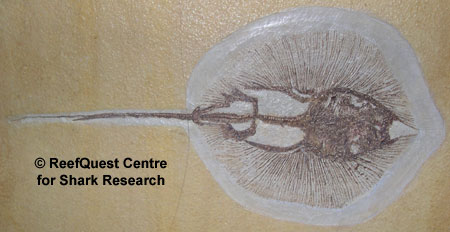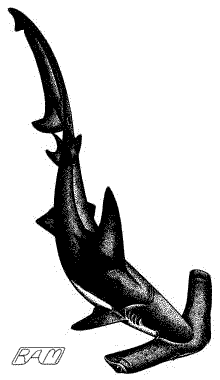The Rise of Modern Sharks
The neoselachians underwent several bursts of adaptive radiation throughout the Jurassic and Cretaceous periods, generating an astonishing diversity of new forms and lifestyles. This most recent flowering of shark diversity is comparable to that which produced the Golden Age of Sharks during the Carboniferous, some 100 million years earlier. Most lineages that resulted from this 'Jurassic Explosion' have continued to evolve along separate paths for nearly 200 million years. Each of these paths is constrained by the limits of neoselachian adaptability and represents a fundamental way of earning a living in the sea.
Cow and Frilled Sharks
Among most ancient of surviving neoselachian lineages are the cow and frilled sharks (orders Hexanchiformes and Chlamydoselachiformes, respectively). Cow sharks are represented in the fossil record by their characteristic cockscomb-shaped lower teeth, dating as far back as the early Jurassic Period, about 190 million-years ago. Articulated cow shark remains are known from the late Jurassic, about 150 million years ago. The eel-like Frilled Shark (Chlamydoselachus anguineus) is probably at least as ancient, but its unique trident-shaped teeth are known only as far back as the late Cretaceous, about 95 million years ago. Although a few cow sharks have secondarily invaded coastal, shallow-water habitats (notably the Broadnose Sevengill, Notorynchus cepedianus and - in certain parts of its range - the Bluntnose Sixgill, Hexanchus griseus), most hexanchoids are dedicatedly deep-sea animals. One is tempted to suspect that these sharks have been 'hiding out' in the stygian blackness of the abyss while their shallow-water cousins competed vigorously with each other for vital resources in the sunlit shallows, far above. But these sharks are not ecological draft evaders, they are simply adapted to making a living in very specialized and difficult surroundings. Yet, because food and other resources are much more abundant over the continental shelves which surround large landmasses, neoselachian diversity and abundance to this day remains richest in these fecund near-shore waters.
Batoids
It was also during the initial Jurassic explosion that a second variation on the sharky theme appeared, the flattened skates and rays. All modern skates, rays, guitarfishes, and sawfishes are derived from a common ancestor and are collectively termed "batoids". Despite their wondrous structural and behavioral diversity, the batoids are united by numerous anatomical characteristics. Most of these features are adaptations to their sprawling-on-the-seafloor mode of life - although a few forms, such as the eagle and manta rays, have secondarily become active and powerful swimmers. The oldest fossil batoids are known from the early Jurassic, represented mostly by isolated teeth and spines. The oldest articulated batoid remains date back to the late Jurassic, about 150 million years ago. These are clearly ancient guitarfishes (family Rhinobatidae), known from well-preserved body fossils in what is now France and Germany. Numerous other batoid lineages appeared in relatively short order, including skates, electric rays, and stingrays.
Stingrays (order Myliobatiformes) include some of the most spectacular and distinctive batoids. These rays made their first appearance in late Cretaceous seas and became widespread in the early Tertiary Period, about 60 million years ago. At about that time, stingrays began invading river and lake habitats. Early Eocene strata (about 50 million years old) of Europe, northern Africa, Asia, Australia, Indonesia, and North America have yielded articulated specimens of a freshwater stingray known as Heliobatis (which means "sun-ray", in reference to its gorgeous radiating fin supports). The Green River shales in Wyoming have surrendered some particularly exquisite specimens, each resembling a piscine supernova frozen in stone. In many respects, Heliobatis resembles the modern river stingrays (family Potamotrygonidae), which have become so adapted to life in freshwater that they can no longer survive in the sea. As a result of their invasion of fresh waters, the river stingrays became trapped by their own physiology. Freshwater habitats have long had their share of ancient sharks, from the early xenacanths (such as Antarctilamna, from 380 million years ago) to certain hybodonts (which persisted in these habitats from the mid-Permian, about 275 million years ago, until the late Cretaceous, about 65 million years ago - slightly later than their relatives in the sea). Today, however, only about 40 species of neoselachian make use of freshwater habitats. But, with the exception of the river stingrays, very few actually complete their entire life cycle in fresh water.

Beautifully preserved whole-body fossils of Heliobatis (some-times called "sun rays") have been recovered from the Green River shales. Due to their exquisite preservation, Heliobatis fossils are highly prized by collectors. Occasionally, fossil hunters find a mother ray with up to four juveniles preserved together. Such fossils fetch particularly handsome prices.
Filter-Feeding Neoselachians
Perhaps the most astonishing and unprecedented expression of neoselachian adaptability is the evolution of filter-feeding sharks and rays. At about the same time during the early-to-mid Tertiary Period, roughly 65 to 35 million years ago, four separate neoselachian lineages independently shifted from active predation to a more laid-back grazing modus vivendi. The carpet shark lineage (order Orectolobiformes) gave rise to the modern Whale Shark (Rhincodon typus), two distinct lineages of mackerel shark (Lamniformes) gave rise to the Basking (Cetorhinus maximus) and Megamouth (Megachasma pelagios) sharks, and the stingrays (Myliobatiformes) gave rise to the devil rays (Mobula species) and Manta (Manta birostris).
All these swimming colanders share four key adaptations that enable them to separate their tiny prey from the saline broth through which they swim: 1) large to enormous size, 2) a very wide terminal or nearly terminal mouth, 3) reduced dentition, and 4) elaboration of the gill tissues to form plankton sieves. We may never know what environmental changes precipitated this profound dietary shift. But it is probably no coincidence that the filter-feeding baleen whales also appeared at about the same time as these planktivorous neoselachians.
Hammerhead Sharks
The strange and wonderful hammerheads (family Sphyrnidae) are among the most recent sharks to appear in the fossil record. The earliest of their single-cusped teeth are known from mid-to-late Eocene deposits, about 50 to 35 million years old. (The origin of hammerheads is difficult to determine precisely, as their teeth are very similar to those of closely related carcharhinids - notably Rhizoprionodon and Scoliodon.) Thus, hammerhead sharks appeared at about the same time as the 'dawn horse', Hyracotherium (better known by its older and more euphonious name, Eohippus) appeared on land - and more than 35 million years before the first ape-like creature that could be considered even remotely human. Hammerheads may seem an improbable design, but they were here long before us.
|
|
Of some eight species of extant hammerhead shark, the Winghead (Eusphyra blochii) has the most 'extreme' hammer - almost half as wide as the rest of the fish is long. Modern genetics techniques have revealed some astonishing things about how this improbable headgear evolved. |

